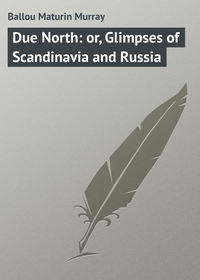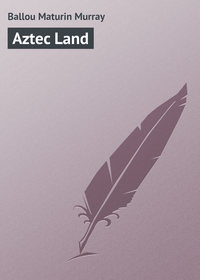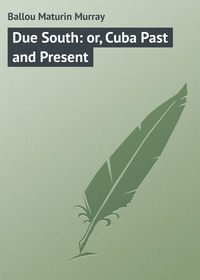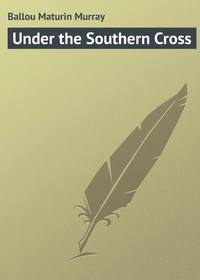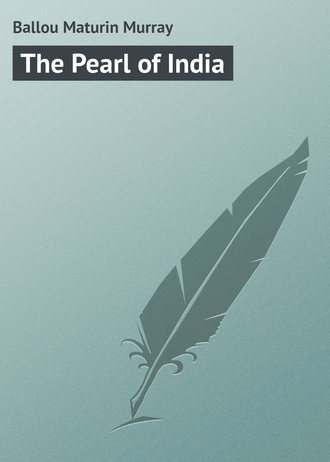 полная версия
полная версияThe Pearl of India
Here and there labyrinths of unexplored ruins are entirely hidden by lofty, broad-limbed trees and a tangle of low, dense shrub, as though the big city had been originally built in a forest. We pause, and gaze thoughtfully at the desolation which speaks so emphatically in its dumb way. It is the language in which the decline and fall of great empires is written, – monuments of mutability.
"Tully was not so eloquent as thee,Thou nameless column with the buried base."It is not to be wondered at that learned European antiquarians make pilgrimages hither to see with their own eyes what others have graphically described, and to translate for themselves these black-letter records of by-gone ages. We met at Pollonarua one enthusiastic traveler who had neither eyes nor ears for anything else but that which related to the almost forgotten past. The mouldering ruins of Ceylon were food and drink to him, with which he gorged himself to repletion. Each new student of antiquity who comes hither, being informed of the progress of those who preceded him, takes up the thread of discovery where they left it, and adds something to illumine the darkness which enshrouds these sombre ruins.
It could not always have been peaceful in these populous cities of the past, where strange gods and strange customs prevailed. The imagination easily depicts dire tragedies and bloody conflicts which must have drenched their broad avenues with blood. Such has been the history of the world since the beginning of time.
The best-preserved construction amid all the ruins is a Buddhist rock-temple, which, having been hewn out of the native stone, is still intact, though supposed to date back three hundred years before our era. It is only a small chamber about twenty feet square, containing an altar and three stone figures of Buddha in different positions, sitting, reclining, and standing. The entrance to the chamber is an archway; on either side, inscriptions are engraven in the Pali language, but these, we were informed, had never been translated. The native rock, from which the small temple is cut, rises abruptly from the level plain.
Anuradhapura, as wonderful in its way as Pompeii or Herculaneum, is known as the ancient capital of Ceylon, and Pollonarua as the mediæval, but even the former is antedated by other half-buried cities in the island, that of Bintenne, for instance, which exhibits ruins of great interest and of admitted antiquity. There is a dagoba here which is spoken of by the former Dutch occupants of the island, in A. D. 1602, as being still in good preservation, surmounted by a gilded dome, while its smooth, white exterior was quite unblemished. The wear and tear of the centuries has not yet obliterated this monument.
These dagobas, shaped like half an eggshell, are very similar to the topes of India proper. The interior consists of earth and sun-dried clay, built about and rendered substantial with burned bricks and tiles, the whole being coated on the exterior with a stone-like mortar or chunam. The burned bricks which are found in the débris of the "buried cities" have their form quite perfect, and were so well fired when made that they still retain their sharpness and consistency. The best examples of brick-work are to be found among the ruins of Pollonarua, where the mortar that was originally used shows the remains of the burned pearl-oyster shells from which it was made. The principle of the true arch secured by its keystone does not seem to have been understood by the people of that period in this island, though what is called the false arch, produced by projecting one layer of bricks beyond another, is clearly shown. The carving in stone was carried to a high degree of excellence, and is still in good preservation, as shown upon slabs, risers to steps, and on octangular columns of graceful proportions. The entrance to some of the cave-temples also exhibits ability in the carving of stone which is of no mean quality, depicting innumerable single figures and many groups. None of the Indian topes are more than half as large as these Ceylon dagobas. The latter were solid, hemispherical masses, standing upon a raised square platform of granite six or eight feet high, and approached by broad stone steps. The incrustation of the dome-like edifice was after the fashion of our modern stucco process, except that it was very much more thickly laid on. The preparation consisted of lime, cocoanut water, and the glutinous juice of a fruit which grows upon the paragaha-tree. This compound was pure white when dried and hardened, receiving a polish like glass, and was remarkable for durability.
We were told of, but did not see, carved stone capitals and elaborately draped monoliths, found among the ruins of Bintenne, which represented early perfection in architecture as displayed in a region now indeed barbaric, but where a civilization flourished in the far past in all the pride and pomp of oriental grandeur. To-day, the jackal and the panther, unmolested by man, prowl about the spot in search of prey.
When the hosts who formed the population of these long-buried cities disappeared we may not know, nor what fate befell them. There are many intelligent theories about the matter, but very little positive evidence. The most plausible supposition would seem to be that a devastating famine must have been the fatal agent. Most of the works which these people left behind them, except the bell-shaped and nearly indestructible dagobas, are now covered with rank vegetation. The first structure of this character erected at Anuradhapura is still extant, and is believed by some writers to be one of the oldest architectural monuments in India. With this conclusion we certainly cannot agree, as the chronicles tell us it was raised by King Tissa, at the close of the third century before Christ, over the collar-bone of Buddha. The author has seen at Benares many sacred structures, some in ruins, which are much more ancient. After all, these milestones of the centuries afford us little data by which to unravel the mysteries of the past in Ceylon. They are only isolated mementos, forming disjointed links in the chain connecting us with by-gone ages, mute but eloquent witnesses of a former and high degree of civilization. The most erudite antiquarian finds no coherent or reliable history in such crumbling monuments; generalities only can be deduced from them, however suggestive and interesting they may prove.
Neither the ancient nor the modern Singhalese seem to have had any distinctive order of architecture, though the variety which they adopted was infinite. Here, among these half-defaced ruins, one detects Egyptian, Greek, Roman, and Moorish inspirations, calculated to puzzle the scientist as to their probable origin. The singular conglomerates of our own day are not more confusing than some of the best-preserved specimens to be found in these ruined cities of ancient Ceylon.
Another notable object of antiquarian interest in the island is recalled in this connection. It is that of a colossal, upright figure of Buddha, a figure hewn out of the solid rock, to which it is still attached, though it is statuesque and not in bas-relief, the original material only furnishing its support at the back. This rude piece of sculpture is fifty feet in height and otherwise duly proportioned, vividly recalling the mammoth bronze statue of Dai-Butsu at Kamakura, in Japan, which is nearly sixty feet in height, though it is represented in a sitting position. Within this statue fifty people can stand together, the interior being fitted like a chapel. As regards antiquity, the Japanese figure is supposed to be but six centuries in age, while that of Ceylon is surely three times as old, and probably four. The great Singhalese statue is now in the jungle, which has grown up about it during centuries of neglect, near to the great Tank of Kalawera. The surrounding rocks were in ancient days turned into a cave-temple with infinite labor, by hewing and excavating them into chambers of suitable dimensions. Without excellent tools of steel and iron, very nearly approaching in efficiency those of our own time, this could not possibly have been accomplished.
The carved pillars, fluted, beveled, and spiral columns, mounds of ruined masonry, crumbling flights of stone steps, ornamental fragments of temples, and granite statues skillfully wrought which are scattered in all directions throughout the jungle, in some instances overgrown by tall trees, attest both departed greatness and far-reaching antiquity. Broken bricks, tiles, and sculpture are so knit together by snakelike tree-roots, while shaded by their lofty branches, as to form one solid mass for hundreds of rods together, dotted here and there by simple wild flowers which modestly rear their delicate petals and perfume the air. One represents the tomb of decayed magnificence and oriental luxury, the other is the sweet and simple emblem of Nature undefiled. Thus she covers up the wrinkles of age with blooming vegetation, screening the mouldering architecture of a forgotten race beneath fresh arboreal and floral beauties. There still remain, though partially buried beneath the earth, the suggestive memorials of a prosperous and energetic people, who were once the possessors of this beautiful Indian isle. These decaying monuments are at the same time indisputable evidence of the high civilization which once existed here, and also, sad to realize, of the deterioration of the Singhalese as a people. However gradual may have been the decadence of the race from the proud condition of their ancestors who built the "buried cities," the contrast is so strong to-day as to seem singularly abrupt, notwithstanding the intervening centuries.
Fifty years ago, it was only at the risk of one's life that these famous ruins of Ceylon could be reached. Such expeditions were not even attempted without a strong escort and governmental aid. Hostile native tribes and equally fatal malarial influences, together with almost impassable forests and unbridged rivers, were all arrayed against the curious visitor. This is now changed so that enterprising travelers can with but little trouble enjoy a view of some of the most extraordinary monuments to be found in the East, and which are of much more than ordinary archæologic and artistic interest.
In this neighborhood, at Vigitapora, are the ruins of a city, once a royal residence, which is more ancient than Anuradhapura. This place was a populous centre five hundred years before the Christian era, of which there seems to be little if any record preserved, even in the comprehensive pages of that national text-book, the Mahawanso.
The native tribes of Ceylon cannot be said to form a progressive race, even under the advantages which modern civilization affords them. Their present condition is one of dormancy. Those who form the rising generation, after enjoying school advantages to a certain degree, on arriving at the age of responsibility lapse, with some exceptions, into the condition of their parents. Thus many of our Western Indians, who in youth have been educated in schools presided over by the whites, return finally to their native surroundings, promptly adopting from choice the barbaric methods and rude life of their roaming tribes. There is a certain wild instinct which it seems almost impossible to eradicate. A few native Singhalese have availed themselves of the opportunities freely extended to them, and have risen to position and influence both with their own race and the European population. There are also descendants of English fathers and native mothers, who, after enjoying special advantages, have developed into intelligent manhood, and who form a recognized element of the community. A native Singhalese is, or was very lately, judge of the supreme court of Ceylon, while the offices of attorney-general and government solicitor were, and we believe still are, filled by natives. Others of the same race are respected as county judges, magistrates, and leading barristers.
So far as current history can be relied upon, we find that Ceylon was, from five hundred years and more before the Christian era up to the time of its annexation to Great Britain, the almost constant victim of foreign and civil wars. Indeed, this seems to have been the chronic condition of the world at that period. The Portuguese first and the Dutch afterward took possession of the island, the latter being finally expelled by the English, who promptly fortified and have held it ever since.
The rapacity, bigotry, and cruelty which characterized the rule of the Portuguese in Ceylon forms one of the darkest pages in the history of European colonization. An eminent writer upon the period says very tersely and truly that these people first appeared in the Indian Ocean in the threefold character of merchants, missionaries, and pirates, more fully illustrating the last named than the other two occupations. No other nation save Spain has written its autobiography in such glaring letters of blood.
When Ceylon was first acquired by the English, it was placed in the hands of the East India Company, being so intimately connected with India proper, of which that organization held control. In 1798, however, it became a possession of the English crown, and was confirmed to Great Britain by the Treaty of Amiens. The dominion of the Portuguese and the Dutch lasted for nearly the same length of time, each holding the island for about one hundred and forty years, both periods being characterized by innumerable conflicts with the natives and with foreign invaders. The Portuguese, and especially the Dutch, left lasting memorials of their occupancy in the form of fortifications, churches, stone dwellings, and the like, which were so well built as to be still serviceable.
The rich pearl fisheries, and the native product of choice, much coveted gems, were constant allurements for the possession of the "resplendent island," causing the surrounding powers to regard it as a vast treasure house, upon whose possessors they cast envious eyes. On taking the island, as already intimated, England adopted prompt and efficient measures to fortify her possession in such a manner that no one has since cared to dispute her claim. In such matters the English have always pursued an omnivorous policy. No spot of land seems too small or too insignificant to tempt their cupidity, and none too large for their capacious maw, – India, for example.
As in the instance of Malta, also under British rule for so many years, Ceylon has thriven and prospered wonderfully, that is to say in a commercial point of view, which after all is the conventional test. Would that the same commendation might apply to the moral and educational condition of the Singhalese! However, where peace and plenty, together with seeming content, prevail, let us not seek for hidden troubles. The island is to-day indisputably a most flourishing agricultural colony, self-supporting, except as regards the military establishment maintained by the home government, which expense is not justly chargeable to Ceylon, whose peaceable inhabitants require no military force to keep them in subjection. The simplest police organization accomplishes this, though in former times, under insufferable tyranny of petty princes and foreign invaders, the Singhalese proved that they could fight for, and hold their own against considerable odds. Unless outrageously oppressed, they are of too peaceable a nature to arouse themselves to open rebellion.
A simple glance at the situation shows great progress throughout the island since it came into the possession of Great Britain. Barbarous habits and institutions have been gradually reformed; taxes which were formerly exhaustive have been greatly modified, and in many instances entirely removed; from a condition of slavery, the masses have been made free, now enjoying entire personal liberty; the districts of the interior, heretofore inaccessible, have been open to easy and safe travel; compulsory labor has been abolished; education has been brought within the reach of all; large sections of territory have been drained, and brought from an unhealthy condition to one of comparative salubrity; mild and just laws are in operation; civil wars and foreign invasions have ceased, and a peaceful condition of every-day life is established. Such are some of the great improvements which have accrued under English rule. This statement is made as a simple matter of fact, not as an argument that England has a legitimate right on the island, any more than she has in India. But the prosperity of the Singhalese is no less a fact, and very pleasant to record.
The population of the island has more than doubled under the present dynasty, while its marketable products have quadrupled. A few pertinent facts occur to us in this connection which must surely interest the general reader.
There are now about three hundred miles of railway in operation on the island, and nearly as many more projected. To supplement this means of transportation there are a hundred and seventy-five miles of organized canal service, a legacy inherited from the Dutch. There are two hundred and fifty post-offices, besides forty telegraphic stations, in connection with which are sixteen hundred miles of telegraphic wire in position. In this march of progress the interests of education have not been entirely forgotten, and upon the whole, the Singhalese have very little to complain of as regards the government under which they live. Fate, however, has decreed that this people, as a nationality, shall gradually pass away and be forgotten, like other aboriginal races. The Alaska Indians are not more surely dying out than are these Singhalese. The most sensitive matter with them and with nearly all orientals is touching the sacredness of their religious rites. With these the English government never interferes, neither here nor in India proper. As we have shown, the orientals are a peaceable race, and will submit to a considerable degree of arbitrary rule touching their political relations, but the moment their religious convictions and ceremonies are interfered with, they become frenzied.
It will be remembered that the great Indian mutiny, which occurred in 1857, was at first incited in the ranks of the natives at Cawnpore and elsewhere by what was thought to be an intentional insult to their religious convictions.
The English, soon after establishing themselves in Ceylon, tried the experiment of forming a battalion of infantry, composed of the natives. When being trained to service, it was nearly impossible, we are told, to teach them not to fire away their ramrods as the real missiles of destruction. There is a certain effeminacy inherent in all rice-eating nations, and yet what did not the former people of this island achieve in the building of great cities, grand palaces, and temples of stone? It would almost seem as though the Singhalese of the present day could not belong to the same race as the people who built Anuradhapura before Christ was born.
Many of the prominent Christian sects have churches and missionary establishments in the island. It has long been a popular missionary field with several denominations, more particularly in the northern part. The most numerous is that of the Roman Catholic Church, whose leaders began their system of proselyting the natives as far back as the first establishment of the Portuguese in Ceylon. The faith which they presented addressed itself with all its theatrical effect to the fancy of the ignorant Singhalese, especially as the cunning priests took good care to mingle certain local Buddhistical ceremonies with those which they introduced. There are shrines and temples in Ceylon, in what are called Roman Catholic districts, where the images of Buddha and the Virgin Mary both hold honored places. Is the worship of one any more idolatrous than of the other? It has been well said that the idol is the measure of the worshiper. People who never thought for themselves were thus attracted. They formed a class whose very ignorance made them easy converts. Had they been able or inclined to reason upon the subject, it would not have been permitted. They had to swallow the creed as a whole, at a single gulp, being approached with the sword in one hand and the cross in the other.
Absolutism in faith is synonymous with ignorance. The right of inquiry is the privilege of every human being, though it is denounced as heretical by the Romish Church. Only falsehood fears investigation; only chicanery dreads the light. The hateful Inquisition tried to carry on its bloodthirsty practices here under Portuguese rule, but was summarily driven out of Ceylon by the Dutch, with its vile nunneries and its instruments of torture. So the French, during their brief possession of the island of Malta, expelled a similar Jesuitical crew from Valetta, not, however, before they had recorded their diabolical deeds in letters of blood, now burning a "heretic," and now mangling an intractable convert.
CHAPTER V
Food of the People. – Rice Cultivation. – Vast Artificial Lakes. – The Stone Tanks of Aden. – Parched Australia. – Coffee Culture. – Severe Reverses among Planters. – Tea Culture. – Cinchona Plantations. – Heavy Exportation of Tea. – Cacao Culture. – A Coffee Plantation described. – Domesticated Snakes. – The Cinnamon-Tree. – Cinnamon Gardens a Disappointment. – Picturesque Dwelling's. – Forest Lands. – The Ceylon Jungle. – Native Cabinet Woods. – Night in a Tropical Forest. – Rhododendrons.
The principal food of a nation is a most important factor, not only in judging of its means of support, but also as regards the mental and physical character of the people themselves. Rice has been the staple product and support of Ceylon, as it has been of the population of India and China, from time immemorial. There are to-day some eight hundred thousand acres of land devoted to the raising of this cereal upon the island; there should be twice that area devoted to the purpose, to meet the imperative wants of the present population. The unsuitability of the climate for ripening wheat is more than compensated for by its prodigal yield of rice, producing two crops annually, where water can be freely obtained. This grain is proven by scientific experiment to contain more of the several essential elements for support of the human body than any other which is grown. As is well known, in cultivating rice, it requires to be flooded, started in fact under water, after being first planted, and also to be more than once submerged during its growth and ripening. To facilitate the production of this nutritious grain, the great tanks already referred to were originally built, in which to preserve, for periodical use, the water which flows freely enough from the mountain region during the rainy season, but when the dry period sets in, the rivers become thread-like streams, fed only by a few inconsiderable springs which exist in the hills. The oldest of these immense reservoirs is believed to date back some centuries before Christ's appearance upon earth, evincing by their construction a degree of organized thrift and effective energy hardly equaled in our time.
The tanks not only saved the precious water from running to waste, but, being tapped at suitable intervals, conducted it by sluiceways and canals, distributing it to those localities where it was needed, and at the exact time when it was wanted.
The chief article of native consumption should also be one of export from a country so admirably adapted to its production. This is not now the case; indeed, it is and has long been one of the principal imports from India and elsewhere. It is estimated that every native adult who can get it consumes a bushel of rice each month in the year. To the Singhalese rice is what wheat is to the average American, namely, the staff of life. To promote its cultivation, the English government should repair the neglected tanks, great and small. There is evidence sufficient to prove that Ceylon raised all she required of this staple for home consumption when her agricultural masses could get the necessary water. In some localities where the rain is plentiful, the rice planter is dependent upon the natural supply; but in most parts of the island its cultivation is not even attempted unless a certain artificial supply of water is first secured by means of canals and reservoirs, it being quite as necessary as the very seed itself. There is one great advantage which the planters enjoy in Ceylon over most other regions; that is, the abundance and cheapness of free labor obtainable at any season of the year. Coolies by the thousand are always ready to come hither from southern India at the harvest time. As many come regularly as can get employment.




